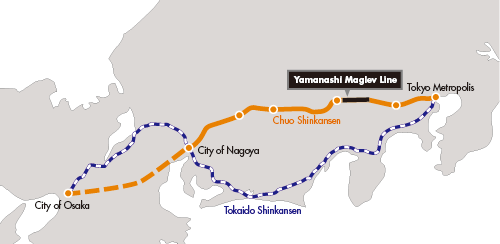Home > Highlighting JAPAN > Highlighting Japan April 2017 > The New Age of Rail
Highlighting JAPAN


Tokyo to Nagoya City in 40 Minutes
The coming age of maglev
More than fifty years have passed since the Tokaido Shinkansen connecting Tokyo and Osaka began operating. Construction of the Chuo Shinkansen, which will connect Tokyo, Nagoya City and Osaka City using a new technology, superconducting maglev, commenced in 2014. The Tokaido Shinkansen was constructed along the Pacific coastline, but the Chuo Shinkansen will run through the inland areas of the Japanese mainland, connecting the three cities in as short a distance as possible.
The superconducting maglev is a contactless transportation system in which the train levitates approximately 10 centimeters due to the magnetic force generated between the on-board superconducting magnets and the ground coils. Because the system causes no friction between the wheels and the rails, unlike conventional railway systems, it enables ultra-high-speed operation. Its operating velocity is 500 kilometers per hour. At its fastest, the superconducting maglev will connect Shinagawa and Nagoya City (a railway length of 285.6 km) in 40 minutes and, further down the line, Tokyo and Osaka City in 67 minutes. (Presently the Tokaido Shinkansen at its fastest connects Tokyo and Nagoya in one hour and 34 minutes and Tokyo and Shin-Osaka in two hours and 22 minutes.) Central Japan Railway Company (JR Central) plans to open the route between Tokyo and Nagoya City, currently under construction as the first phase, in 2027.
One of the reasons for constructing the Chuo Shinkansen is to reduce multiple risks by building another line along the main artery connecting Tokyo, Nagoya City and Osaka City, which is vital for Japanese society. The Tokaido Shinkansen has now been operating for more than fifty years, and it will need to be fully prepared against aging degradation and large-scale disasters in the future. The opening of the Chuo Shinkansen will enable the impact of the improvement work for the Tokaido Shinkansen to be reduced. In addition, building another line along the main artery will be effective in preparing for disaster risks, including major earthquakes.
The Chuo Shinkansen is also expected to produce enormous synergistic effects on the economy and society. It will be effective in forming a huge integrated urban zone made up of Japan’s three largest metropolitan areas — the Greater Tokyo Metropolitan area, the Chukyo area adjacent to Nagoya City and the Kinki area adjacent to Osaka City. This is expected to create wider regions for human activities, which will lead to major lifestyle changes, such as how business is carried out and how leisure is enjoyed.
Research into the superconducting maglev started in 1962 and running tests began in Miyazaki Prefecture in 1977. Running tests began on the 18.4-kilometer Yamanashi Maglev Line in Tsuru City, Yamanashi Prefecture in 1997. The Yamanashi Maglev Line was extended to 42.8 kilometers in 2013 and will be used as part of the Chuo Shinkansen in the future. Currently, running tests of Series L0, a railcar of the operating line specifications, are being conducted on the Yamanashi Maglev Line. The front railcar of Series L0 is 28 meters in length. This series is characterized by its 15-meter long “nose” to reduce air drag. In 2015, a manned running test recorded 603 kilometers per hour, the world’s fastest velocity for a railway. Although JR Central has already established the practical technologies for superconducting maglev, it continues to work on the upgrading of technologies such as those connected with improvement of comfort and efficiency of maintenance with a view toward the opening of the Chuo Shinkansen between Shinagawa and Nagoya City.
At the Yamanashi Prefectural Maglev Exhibition Center, which is located along the Yamanashi Maglev Line, you can watch the superconducting maglev run at ultra-high speed up close. There are also displays featuring the actual prototype of a test railcar that set the world record of 581 kilometers per hour in 2003 and a machine introducing the mechanism of the superconducting maglev. In addition, JR Central began conducting a lottery-based experience program for the superconducting maglev in 2014, and a total of more than 50,000 people have experienced journeys of 500 kilometers per hour to date.
Currently, there is a plan for high-speed railways based on the Japanese superconducting maglev technology in the United States as well. The superconducting maglev is expected to dramatically change the future of Japanese and global railways.


© 2009 Cabinet Office, Government of Japan






